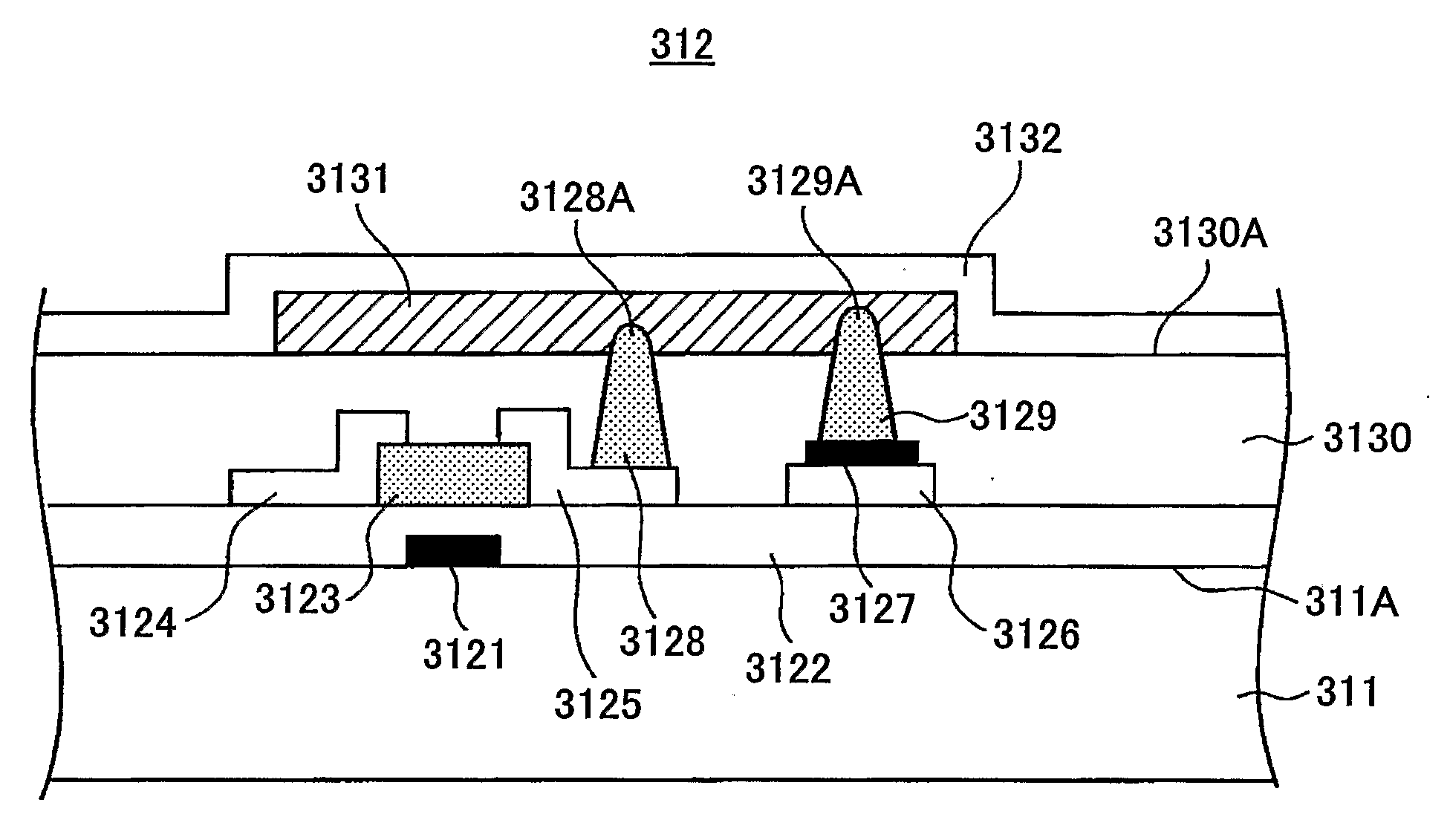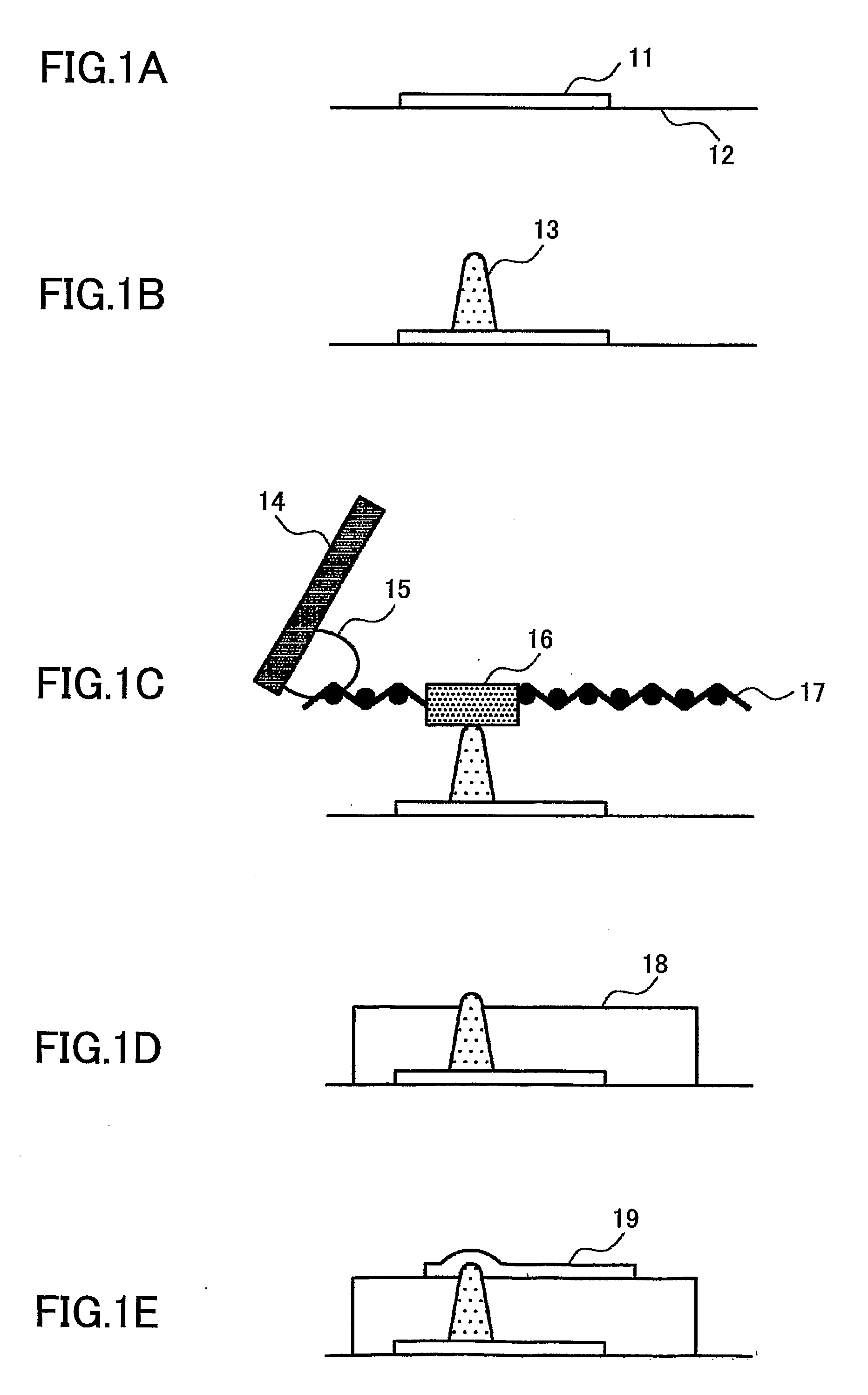Multilayer wiring structure and method of manufacturing the same
a multi-layer wiring and manufacturing method technology, applied in the direction of resistive material coating, printed circuit assembling, non-metallic protective coating application, etc., can solve the problems of increasing contact resistance, reducing long-term reliability of printed boards and ceramic substrates, and voids and air bubbles that remain, so as to achieve small voltage loss and high potential
- Summary
- Abstract
- Description
- Claims
- Application Information
AI Technical Summary
Benefits of technology
Problems solved by technology
Method used
Image
Examples
embodiment 1
[0118]FIGS. 1A-1E illustrate a method of manufacturing a multilayer wiring structure according to Embodiment 1 of the present invention.
[0119]In the step shown in FIG. 1A, a first metal wiring element 11 is formed on a glass substrate 12 using a screen printing method. A conductive paste used herein for printing is an Ag paste that contains Ag particles, acrylic resin, carbitol acetate, etc., and has a viscosity of 100-220 Pa·s. It is to be noted that the viscosity measurement is performed at 10 rpm using Brookfield HBT No. 14 spindle at room temperature. These conditions are applied to other viscosity measurements that follow. A screen mask used herein is a stainless mesh No. 500 with an emulsion thickness of 8 μm. The first metal wiring element 11 having a width of 50 μm is printed with the Ag paste, using the above screen mask and a squeegee 14 having a rubber hardness of 70. The land diameter of a via hole through which the first metal wiring element 11 and a second metal wiring...
embodiment 2
[0144]The following describes Embodiment 2, again with reference to FIGS. 1A-1E.
[0145]In the same way as in Embodiment 1, a first metal wiring element 11 (having a width of 50 μm and a land diameter of 150 μm) is formed on a glass substrate 12, and then a via post 13 is formed on a land of the first metal wiring element 11. The via post 13 has a head size of 50-60 μm and a height of 11-13 μm.
[0146]After that, an insulation paste 15 is printed by screen printing and cured by heating so as to form an interlayer insulation film 18. A screen mask 17 used herein has a non-ejection area 16. The design rule of a distance OL between the non-ejection area 16 and the via post 13 with one side is in a range of 10-50 μm. An insulation paste 15 and a squeegee 14 used in Embodiment 2 are the same as those in Embodiment 1.
[0147]Then, in the same way as in Embodiment 1, a second metal wiring element 19 (having a width of 100 μm and a land diameter of 150 μm) is formed on the surface of the interlay...
embodiment 3
[0154]The following describes Embodiment 3, again with reference to FIGS. 1A-1E.
[0155]In the same way as in Embodiment 1, a first metal wiring element 11 (having a width of 50 μm) is formed. Then, a via post 13 having a diameter of 50 μm is formed on a land of the first metal wiring element 11 using the dispenser method. A conductive paste used herein for printing is an Ag paste that contains Ag particles, acrylic resin, butyl carbitol, etc., and has a viscosity of 300-600 Pa·s.
[0156]More specifically describing the above process, the substrate 12 is absorbed on a substrate stage of a dispenser by vacuum, and an alignment mark of the first metal wiring element 11 is read by a CCD camera to find the position of the substrate 12. Then, a printing pattern is input to the dispenser, and the Ag paste is applied to the land of the first metal wiring element 11 so as to form the via post 13. The Ag paste is cured by heating in an oven at 250° C. for 20 minutes to finish the via post 13. Th...
PUM
| Property | Measurement | Unit |
|---|---|---|
| Length | aaaaa | aaaaa |
| Area | aaaaa | aaaaa |
Abstract
Description
Claims
Application Information
 Login to View More
Login to View More - R&D
- Intellectual Property
- Life Sciences
- Materials
- Tech Scout
- Unparalleled Data Quality
- Higher Quality Content
- 60% Fewer Hallucinations
Browse by: Latest US Patents, China's latest patents, Technical Efficacy Thesaurus, Application Domain, Technology Topic, Popular Technical Reports.
© 2025 PatSnap. All rights reserved.Legal|Privacy policy|Modern Slavery Act Transparency Statement|Sitemap|About US| Contact US: help@patsnap.com



